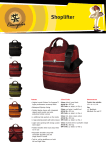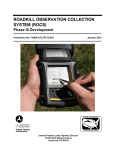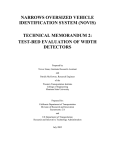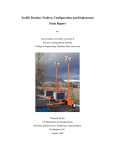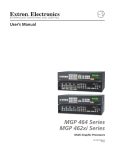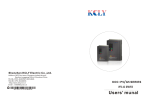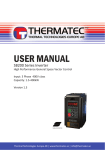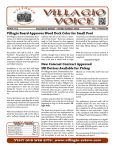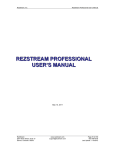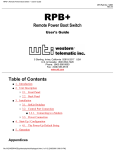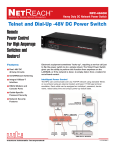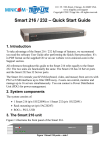Download Roadkill Observation Collection System (ROCS)
Transcript
Roadkill Observation Collection System (ROCS) Development of an Integrated Personal Digital Assistant (PDA) with a Global Positioning System (GPS) to Gather Standardized Digital Information By Rob Ament, Road Ecology Program Manager Doug Galarus, Program Manager – Systems Engineering, Development and Integration Hugh Richardson, Research Associate Amanda Hardy, Research Ecologist Western Transportation Institute College of Engineering Montana State University A report prepared for the Virginia Transportation Research Council And the Washington State Department of Transportation August 2, 2007 Roadkill Observation Collection System (ROCS) Disclaimer DISCLAIMER The opinions, findings and conclusions expressed in this publication are those of the authors and not necessarily those of Montana State University. Alternative accessible formats of this document will be provided upon request. Persons with disabilities who need an alternative accessible format of this information, or who require some other reasonable accommodation to participate, should contact Kate Heidkamp, Assistant Director for Communications and Information Systems, Western Transportation Institute, Montana State University-Bozeman, PO Box 174250, Bozeman, MT 59717-4250, telephone number 406-994-7018, e-mail: [email protected]. Western Transportation Institute ii Roadkill Observation Collection System (ROCS) Acknowledgements ACKNOWLEDGEMENTS This work was conducted as part of separate contracts with the Virginia Transportation Research Council (VTRC) and the Washington State Department of Transportation (WSDOT). We would like to thank Bridget Donaldson of VTRC and Kim Vaughn of WSDOT for their interest in partnering with WTI in pursuit of the development of this new technology. The original concept was the brainchild of Marcel Huijser and Amanda Hardy, both research ecologists, and Doug Galarus, a systems engineer, all at WTI. They published a poster on the proof-of-concept model at the 2005 International Conference in Transportation and Ecology. The System’s initial development was supported with funding from the U.S. Department of Transportation’s Research and Innovation Technology Administration. The following people provided support and assistance on the project: Sean Graham for assistance in development and maintenance of the ROCS system and Carol Diffendaffer for her review and editing of this report. Finally, thanks to Marcel Huijser and Amanda Hardy of WTI for the use of photos from their research. Western Transportation Institute iii Roadkill Observation Collection System (ROCS) Table of Contents TABLE OF CONTENTS 1. Introduction..............................................................................................................................1 2. Background ..............................................................................................................................2 3. Roadkill Observation Collections System (ROCS): A Multi-Phase Development Process....3 3.1. Phase I: Proof-of-Concept (Completed) ......................................................................... 3 3.2. Phase II: Current ROCS Development and Status.......................................................... 4 3.3. Phase III: Robust, Broad Geographic Deployment (Future) .......................................... 4 4. ROCS Technical Developments ..............................................................................................5 4.1. Personal Digital Assistant (PDA) ................................................................................... 6 4.2. Global Positioning System (GPS)................................................................................... 6 4.3. PDA-GPS Program Development................................................................................... 6 4.4. Desktop Application Development................................................................................. 6 5. Field Tests..............................................................................................................................10 5.1. User’s Guide ................................................................................................................. 10 5.2. Field Test Sites.............................................................................................................. 10 5.3. Field Test Survey and Feedback ................................................................................... 11 6. Deliverables ...........................................................................................................................14 7. Conclusions............................................................................................................................15 8. Recommendations..................................................................................................................16 9. References..............................................................................................................................17 10. Appendix A: ROCS User’S Guide V.2..............................................................................18 11. Appendix B: ROCS Field User’s Survey...........................................................................19 Western Transportation Institute Page iv Roadkill Observation Collection System (ROCS) List of Figures List of Figures Figure 1. Deer Warning Sign (Photo: Marcel Huijser/WTI). ........................................................ 1 Figure 2. Proof-of-concept PDA-GPS hand held data collector (Photo: Marcel Huijser/WTI)..... 3 Figure 3. PDA-GPS Hand-held Data Collector (Photo: Amanda Hardy/WTI)............................. 5 Figure 4. Example of Output on a Map from an Approximate 45 mile Data Collection Session Along US Highway 191 in Montana with 4 Roadkills Recorded........................................... 7 Figure 5. Roadkill Locations on Google Earth Map...................................................................... 8 Figure 6. User Interface for Desktop Application .......................................................................... 9 Figure 7. Virginia Training Session (Photo: Amanda Hardy/WTI). ............................................ 11 Figure 8. Washington Training Session (Photo: Amanda Hardy/WTI). ...................................... 13 Western Transportation Institute Page v Roadkill Observation Collection System (ROCS) Introduction 1. INTRODUCTION Animal-vehicle collisions are an important transportation challenge across North America. In the 1990s, the number of ungulate-vehicle crashes was estimated at 725,000-1,500,000 annually in the US. These collisions were estimated to cause more than 200 human fatalities and over one billion dollars in property damage a year. These numbers are likely to have increased even further over the last decade. In a growing number of states, wildlife-vehicle collisions are one of the top safety issues that generate interest and concern with the public. To design effective countermeasures, transportation agencies need accurate data about where, when, and how accidents occur. Despite all the advancements that have been made in information technologies, most data on wildlife-vehicle collisions is still collected in sporadic efforts using a pen and paper. From both management and research perspectives, the information is difficult to analyze, because of limited standardization and inconsistent or often poor spatial resolution. A need for consistent, spatially accurate data collection has been articulated by many transportation departments and natural resource agencies across the US and Canada. The Western Transportation Institute at Montana State University (WTI) is working with the Virginia Transportation Research Council and the Washington State Department of Transportation to develop a tool to help standardize accurate data collection of wildlife vehicle collision occurrences. This tool integrates a handheld computer or personal digital assistant (PDA) with a global positioning system (GPS) that is supported by customized software to aid in easy, spatially accurate and consistent wildlife-vehicle collision data collection. Figure 1. Deer Warning Sign (Photo: Marcel Huijser/WTI). Western Transportation Institute Page 1 Roadkill Observation Collection System (ROCS) Background 2. BACKGROUND Animal-vehicle collisions affect human safety, cause property loss and kill or injure wildlife. The number of animal-vehicle collisions has substantially increased across much of North America in the past two decades and are becoming a larger component of overall crashes in the United States (Huijser et. al, 2007a). Systematically collected animal-vehicle collision (AVC) data help quantify the magnitude of the problem and help record potential changes in AVCs over time. Such data allows for the identification and prioritization of locations that may require mitigation. Furthermore, systematically collected animal-vehicle collision data allow for the evaluation of the effectiveness of mitigation measures in reducing the number of animal-vehicle collisions. A survey of U.S. states’ and Canadian provinces’ departments of transportation (DOTs) and departments of natural resources (DNRs) indicates that most of the responding DOTs (65%) and some DNRs (36%) collect AVC data (Huijser et al., 2007b). A survey of the U.S. National Park Service indicates that of those management units that have public roads, only one half of the respondents indicated they collect some sort of data on wildlife mortality caused by vehicles (Ament et al., 2007). Huijser and others’ National Cooperative Highway Research Program (NCHRP) draft final report (2007b) indicates that spatial accuracy of crash locations was often lacking. In yet another NCHRP study currently being finalized, of the 25 top research and practice priorities related to wildlife and transportation in North America, number 7 is “use standardized and vetted protocols for collecting and recording road kill carcass and animalvehicle collision data.” (Cramer and Bissonette, 2006) The facilitation of AVC data collection with a spatially accurate, efficient and easy to use system that decreases manual collection and data entry has the potential to increase AVC data collection across North America by a variety of state, provincial and federal transportation and natural resource agencies. The advantages of a standardized animal-vehicle collision data collection program, as stated in Huijser et al. (2007b) are: • The occurrence of incidents that affect human safety, natural resource conservation, and monetary losses are documented; • Changes in animal-vehicle collisions in time or space can be documented; • Locations that may require mitigation can be identified and prioritized, allowing for an effective use of resources; and • The effectiveness of mitigation measures in reducing collisions can be evaluated. This allows for modifications (if needed) and the application of lessons learned at other locations, again allowing for an effective use of resources. Western Transportation Institute Page 2 Roadkill Observation Collection System (ROCS) A Multi-Phase Development Process 3. ROADKILL OBSERVATION COLLECTIONS SYSTEM (ROCS): A MULTI-PHASE DEVELOPMENT PROCESS 3.1. Phase I: Proof-of-Concept (Completed) In 2005, the Western Transportation Institute (WTI) used $15,000 of University Transportation Center (UTC) funding to develop a proof-of-concept system (hardware and software). An offthe-shelf Dell Axim Personal Data Assistant (PDA) (Microsoft-based) and Pharos Global Positioning System (GPS) were integrated with custom-developed software to form the proof of concept system. Key features included: • • • An easy to use interface that facilitates rapid data entry; Standard, text-based, storage of observations and paths; and two modes: continuous monitoring or incidental observation The unit was field tested by WTI and demonstrated to a number of prospective users. A selftutorial CD to demonstrate the operation of the unit was also developed. An evaluation of the project indicated that it was an effective and precise data collector and easy to operate. One weakness known from the start was that the original PDA-GPS combination was vulnerable to damage during field use. Furthermore, desktop computer applications would need to be developed to make the data easy to download, display on maps, and prepare for analyses. This phase was completed in early 2006. The development and success of this proof-of-concept model was shared with the transportation community at the biennial meeting of International Conference of Ecology and Transportation 2005 (Huijser et. al, 2006). Figure 2. Proof-of-concept PDA-GPS hand held data collector (Photo: Marcel Huijser/WTI). Western Transportation Institute Page 3 Roadkill Observation Collection System (ROCS) 3.2. A Multi-Phase Development Process Phase II: Current ROCS Development and Status The Virginia Transportation Research Council and the Washington Department of Transportation partnered with WTI to further develop this tool for practical use by highway maintenance crews, agency biologists, or research scientists. At the onset of this phase of development, the ultimate purpose of the ROCS was to provide both management and maintenance personnel with a tool that allows them to efficiently and effectively fulfill information gathering tasks for roadway segments or at particular sites of interest. The product was to provide maintenance and management personnel with a multipurpose tool that aids in 1) managing highway systems using quality information and procedures; 2) reducing motor vehicle accidents involving wildlife; and 3) planning means of mitigating highway impacts on wildlife populations. It was envisioned that if the field tests were satisfactory, the ROCS may be become part of the standard practice of road maintenance crews and other DOT staff for collecting animal-vehicle collision data. 3.3. Phase III: Robust, Broad Geographic Deployment (Future) This stage is slated to deploy the ROCS across large geographical regions for wide-spread data collection, collation and storage (i.e., for district, state-wide, regional or national applications). The intent is to develop server capabilities to store collected data on a single platform for systematic state-wide, regional or national applications; this may include developing a single server for uploading all data or developing server software that can be downloaded by different users. Ultimately, the goal of this project is to standardize, systematize and integrate disparate datasets in one location with confidence in the methodology and the quality of data. Additionally, the development of national animal-vehicle collision data collection standards would help federal and state agencies with quality assurance and quality control for broader applicability. Further, Phase III would develop a means of bundling the ROCS software with other programs to collect other important spatial data (i.e., highway maintenance or infrastructure information). At the end of Phase III, the PDA-GPS units and supporting server software could be used by individual entities, organizations or agencies to operate and maintain a standardized animalvehicle collision data collection, analyses and reporting system. The same units could also be used to systematically collect information on highway infrastructure needs and assessments or other spatial data needs, such as highway accident reporting. Western Transportation Institute Page 4 Roadkill Observation Collection System (ROCS) ROCS Technical Developments 4. ROCS TECHNICAL DEVELOPMENTS Development was conducted using an iterative process, using rapid prototyping to demonstrate and test functionality with end users and to determine technical feasibility of hardware and software. The first “proof-of-concept” version of the system used non-rugged, off-the-shelf components to facilitate rapid development and to demonstrate the prospective use of the system. This proof-of-concept system was developed using WTI internal funds from the University Transportation Center (UTC) program. Given what was learned in the Proof-of-Concept project, the Phase II development of ROCS had several objectives: • Identify and test a rugged integrated PDA/GPS in various locations; • Further develop software for the PDA-GPS unit to collect the necessary road kill information important for departments of transportation and natural resource agencies; • Assure data storage and back-up capabilities in the hand-held data collector are adequate so that information has a low probability of being lost; and • Develop software in the hand-held data collector so that the data that is stored can be readily transferred to a personal computer and can be used in commercially available software programs for display, analysis, and interpretation. WTI obtained rugged PDA units with an integrated GPS for use in the field. This allows the hand-held units to withstand reasonable wear and the GPS unit isn’t prone to damage or breakage. Additionally, the data collection software was modified and expanded to allow for easy data management and analyses. Lastly, the newer version of the PDA-GPS software developed by WTI allows data to be downloaded from the hand-held units to a personal computer and then made readily available for use in commercially available spreadsheet, statistics and GIS software programs. Once stored on a computer, users are able to easily analyze and interpret the data for better highway management and wildlife mitigation planning. Figure 3. PDA-GPS Hand-held Data Collector (Photo: Amanda Hardy/WTI). Western Transportation Institute Page 5 Roadkill Observation Collection System (ROCS) 4.1. ROCS Technical Developments Personal Digital Assistant (PDA) Commercially-produced by Trimble Corporation, the PDA units called RECON, can be fully submersed in water and are shock resistant. The PDAs run the Windows Mobile 5.0 operating system. Following are the manufacturer’s operating capabilities for the PDAs: • Accidental Drops: up to 4 feet; • Accidental Immersion: 1 meter/30 minutes; • Sealed from dust and sand; • Operation Temperatures: -22 to 140 degrees F; • Battery Life per Charge: 12-15 hours; • 2 Data Storage Locations: flash memory card and internal memory; and • Potential Data Collection: > 2 weeks 4.2. Global Positioning System (GPS) The GPS is also a commercially available unit that was developed to readily plug in to the RECON and other PDAs. It is a Global Sat SIRF 3, compact flash GPS. The ROCS application communicates with the GPS using standard serial (RS-232) communications. Following are the operating capabilities for the GPS unit: • Requires locating 3 satellites (2-d fix); • Accuracy (lat-long): 5-10 meters; and • Accuracy (elevation): not as accurate. 4.3. PDA-GPS Program Development The ROCS application was developed for the Windows Mobile 5.0 platform using Microsoft’s C# programming language and the .NET runtime. The program monitors and logs GPS location information, and geo-locates road-kill observations as they are entered. The trail followed during a monitoring session is recorded entirely. Comma-separated-value (CSV) files are used to store data, and Microsoft ActiveSync is used to transfer data from the PDA to a desktop computer. Data is backed up to storage on a secure digital (SD) memory card to provide redundant storage in the event of a device’s memory failure. This provides the necessary safety feature to ensure data is not lost. 4.4. Desktop Application Development Data can be readily imported into Excel, ArcGIS, and other analysis tools using ActiveSync and the CSV files recorded by the ROCS application. Figure 4 shows data from a data collection session in MapPoint. Western Transportation Institute Page 6 Roadkill Observation Collection System (ROCS) ROCS Technical Developments Figure 4. Example of Output on a Map from an Approximate 45 mile Data Collection Session Along US Highway 191 in Montana with 4 Roadkills Recorded. Further work has been conducted to develop a desktop management and visualization application for ROCS data. This application is considered “proof-of-concept” at this time, and has not been pilot-tested. Such testing would occur in a subsequent phase of the project. It is not seen as “feature-complete” either, since only informal user input has been solicited in terms of specifying functionality and uses of desktop applications. The current “proof-of-concept” desktop application provides database storage for observation data. It is capable of exporting simple data and map images. The desktop application consists of a Microsoft Access database and a graphical user interface. The application allows the user to conveniently bulk load field observation data from the hand-held PDA-GPS unit into the database. The user can then query the database and export the results in Keyhole Markup Language (KML) or Comma-Separated Value (CSV) format. KML format is used by Google Earth (see Figure 5) and other mapping software applications. Western Transportation Institute Page 7 Roadkill Observation Collection System (ROCS) ROCS Technical Developments Figure 5. Roadkill Locations on Google Earth Map. The CSV format is useful for data import into spreadsheets and other applications. Queries and exports can be conducted for both road kill observations and the coordinate log (the pathway of each recording session). See Figure 6 for an example of a spreadsheet of coordinate logs. Western Transportation Institute Page 8 Roadkill Observation Collection System (ROCS) ROCS Technical Developments Figure 6. User Interface for Desktop Application Western Transportation Institute Page 9 Roadkill Observation Collection System (ROCS) Field Tests 5. FIELD TESTS The purpose of the Phase II of ROCS was to test the rugged PDA-GPS data recorders in the field by prospective users, and then further refine the system based on feedback from these users before, during, and after field testing. The field test has led to practical modifications and customization of the software. In addition, WTI researchers were able to improve the userfriendliness of the handheld units to allow for simpler data collection; this was important to ensure that road maintenance crews or others that collect animal-vehicle collision data are able to easily operate the system, which ultimately leads to a decreased workload. 5.1. User’s Guide In preparation for field testing, a User’s Guide was developed for participants. The 31-page document provides information on the features of the hand-held data collector and provides a step-wise progression of instructions to record data (Appendix A). In addition to the User’s Guide a “Quick Guide” was developed as a handy one-page reference for explanations of more common operations of the ROCS device. 5.2. Field Test Sites WTI had the PDA-GPS units tested in the field by a variety of users throughout North America. WTI staff conducted field training sessions for users in Washington, Virginia and Montana. Following is a list of locations and users of the Phase II prototype: LOCATION USER Virginia I-64 and I-81 (Rockbridge Co.) Virginia DOT Maintenance Washington I-90 Washington DOT Maintenance Northern California US Forest Service Alberta, TransCanada Highway Western Transportation Institute/Parks Canada Montana I-90 Craighead Environmental Research Institute Idaho, State Highway 75 Western Transportation Institute Western Transportation Institute Page 10 Roadkill Observation Collection System (ROCS) Field Tests Figure 7. Virginia Training Session (Photo: Amanda Hardy/WTI). 5.3. Field Test Survey and Feedback WTI developed a short survey that was distributed to users of the prototype from Phase II. Seven responses were received providing feedback on the strengths and weaknesses of the PDAGPS device and its programs (Appendix B). Comments were made on problems that arose as the units were being used. The results are summarized as follows: NOTE: the averages in parentheses are from the survey asking respondents to rate on a scale of 1 to 10. Strengths • Except for one respondent most users were very comfortable using the ROCs device (average 9.4). • Training was considered very helpful by the 3 respondents who received field training by WTI (average 10). • Most respondents appreciated the user’s guide and quick guide, finding them helpful (average 8.5); however, one respondent commented that the User’s Guide wasn’t very friendly and the Quick Guide was too brief. • Of the four that responded, three thought a “help section” within the ROCS application was necessary (average 7.5), while one respondent felt it was not necessary. Western Transportation Institute Page 11 Roadkill Observation Collection System (ROCS) Field Tests • Only one respondent received an error message while entering information in the ROCS device. • The GPS consistently obtained a two dimensional “fix” and consistently maintained it during the data collection sessions. • Transferring data from the handheld device to a personal computer was accomplished by four of the respondents. Three used a guest partnership and one used a standard partnership. Two of the four responded that development of automated upload software would help effectively transfer data. • Of the four responding, all felt the organization of the data was intuitive (1 directory per session with up to three separate data files). • All respondents characterized the PDA-GPS unit as reliable. • Respondents appreciated the unit was small and easy to handle. • The unit was tested in extreme cold, moisture and dropped. No functionality was lost as a result. • Four responded that the battery power was sufficient for their organization’s use, one did not. Weaknesses • Two respondents were not comfortable downloading information from the ROCS device to a personal computer (average 6.4, where 10 is very comfortable downloading information). • One respondent’s device had to be shut off and rebooted before it would get a “fix” of the satellites for the GPS. • Another respondent’s unit would not start up or turn on. Resetting fixed the problem. • One respondent had to perform a reset due to dead batteries; however, no data was lost as a result. • All respondents agreed it would be favorable to be able to change species list or other drop down lists. • Several respondents noted that ROCS is best used with 2 people, that driving and recording data is difficult. Other Pertinent Information from the Survey The following software programs were used to upload and manipulate the ROCS device data: MS Access, Arc Map, Arc GIS, Excel, DNR Garmin, Garmin Mapsource, GarTrip, Arc Explorer and Arc View. Most of these programs had no difficulties with importing the ROCS data, however, one respondent noted that in Excel, it is required to manipulate two separate files (the GPS “log” and the carcass “observations”). Western Transportation Institute Page 12 Roadkill Observation Collection System (ROCS) Field Tests Respondents commented that broader geographical applications and integrating ROCS with other spatial data collection (i.e., accidents, infrastructure) are potential desirable future applications. Figure 8. Washington Training Session (Photo: Amanda Hardy/WTI). Western Transportation Institute Page 13 Roadkill Observation Collection System (ROCS) Deliverables 6. DELIVERABLES WTI was able to provide the project’s sponsors the following resources: • Field training sessions for transportation maintenance personnel in Virginia and Washington. • 2 hand-held PDA-GPS units that have been field tested, are rugged, have been programmed to collect the requested road kill information, and have backup memory so data won’t be lost. • Software programming that allows data collected by the ROCS units to be readily downloaded to a variety of commercially available software programs to analyze and view results. • An instruction manual that provides new users to be familiarized and trained to operate the ROCS units. Western Transportation Institute Page 14 Roadkill Observation Collection System (ROCS) Conclusions 7. CONCLUSIONS As a result of Phase II development, ROCS has been field tested, and is capable of: • Standardized, spatially-precise data; • User-friendly data entry in field; • Data downloads that reduce post-field data entry and simplify data management; • Digital comma-delimited output files can be imported into a variety of PC software programs; • Distinguishes between “monitoring” and “incidental observations”; • Tracks monitoring route and time spent collecting information; and, • With standardized and regular AVC monitoring efforts and spatially-accurate data, ROCS is better able to determine where to prioritize highway-wildlife mitigation investments. Western Transportation Institute Page 15 Roadkill Observation Collection System (ROCS) Recommendations 8. RECOMMENDATIONS As a result of the development of software programs for Phase II hardware, field testing and user feedback it is apparent that ROCS is a reliable and capable data collection system. If made available for further refinement and development to meet the needs of transportation and natural resource agencies, it has the potential for: • Additional data collection modules (e.g., for culvert/fish passage inventories, roadway accidents, structural maintenance features); • Further customized development of data management, visualization, and analysis options; • Broader geographic deployment; • Encouragement for adopting national standards for wildlife vehicle collision data collection; and, • Use with an on-line data center to archive/access standardized datasets from across jurisdictions or the United States and Canada (meta analyses). Western Transportation Institute Page 16 Roadkill Observation Collection System (ROCS) References 9. REFERENCES Ament, R., Clevenger, A.P, Yu, O., and Hardy, A. 2007. An Assessment of Road Impacts on Wildlife Populations in U.S. National Parks, WTI-MSU Technical Report REP-07-01, 37 pp. Cramer, P. C., and J. A. Bissonette. 2006. North American priorities for transportation and wildlife research and practice. In: J. Bissonette (ed.) Evaluation of the Use and Effectiveness of Wildlife Crossings: Interim Report, Prepared for the National Cooperative Highway Research Program, Transportation Research Board, National Research Council, June 2006. Huijser, M.P., D.E. Galarus and A. Hardy. 2006. Software for Pocket PC to Collect Road-Kill Data. Page 640, in: Proceedings of the 2005 International Conference on Ecology and Transportation. Center for Transportation and the Environment, North Carolina State University, Raleigh, NC, USA. Huijser, M. P., McGowen, P., Fuller, J., Hardy, A., Kociolek, A., Clevenger, A.P., Smith, D. and Ament, R. 2007a, (in prep.) National Wildlife Vehicle Collision Study: A Report to the U.S. Congress. Western Transportation Institute – Montana State University. Prepared for the Federal Highway Administration, Washington, DC, USA. Huijser, M.P., J. Fuller, M.E. Wagner, A. Hardy & A.P. Clevenger. 2007b, (in prep.). Animalvehicle collision data collection: Second Draft Report. NCHRP Project 20-05/Topic 3712.Western Transportation Institute - Montana State University. Prepared for the Transportation Research Board of the National Academies, Washington, DC, USA. Western Transportation Institute Page 17 Roadkill Observation Collection System (ROCS) Appendix A 10. APPENDIX A: ROCS USER’S GUIDE V.2 Western Transportation Institute Page 18 Roadkill Observation Collection System (ROCS) User’s Guide Western Transportation Institute College of Engineering Roadkill Observation Collection System User’s Guide Introduction ROCS Introduction Project Background Animal-vehicle collisions are an important issue across North America. In the 1990s, the number of ungulate-vehicle crashes was estimated at 725,000-1,500,000 annually in the US. These collisions were estimated to cause over 200 human fatalities and over one billion dollars in property damage a year. These numbers are likely to have increased even further over the last decade. In a growing number of states, wildlife-vehicle collisions are one of the top safety issues that generate interest and concern with the public. Yet today, most data collected on wildlife-vehicle collisions has been the result of sporadic efforts primarily using a pen and paper, with limited standardization and inconsistent or often poor spatial resolution. A need for consistent, spatially accurate data collection has been articulated by many transportation departments across the US and Canada. The Western Transportation Institute at Montana State University (WTI-MSU) is developing a tool to help standardize accurate data collection of wildlife-vehicle collision occurrences. This tool integrates a handheld computer or personal data assistant (PDA) with a global positioning system (GPS) that is supported by customized software to aid in easy, spatially accurate and consistent wildlife-vehicle collision data collection. Phase 1: Proof-of-Concept (Completed) WTI-MSU, using University Transportation Center funding, developed software for an off-the-shelf PDA combined with a GPS (PDA-GPS). This software makes wildlifevehicle collision data collection easy, spatially accurate, and consistent. The initial proof-of-concept software was sound and the data collected was accurate, efficient to gather, and the hand-held units had the ability to collect additional information (e.g., the track of the route followed in recording data). Next steps were identified to prepare the Roadkill Observation Collection System (ROCS) for pilot testing in the field by prospective users. The most urgent need was to identify rugged hardware that could withstand field use. Another identified need was software to assist in downloading and managing data on desktop computers and servers as well as utilities to prepare data for analysis in Geographic Information Systems (GIS) or statistical packages. Phase 2: Current Project Development and Status (In-Process) The Virginia Department of Transportation (DOT) and Washington DOT have partnered with WTI-MSU to further develop this tool for practical use by highway maintenance crews, agency biologists, or researchers. Two other potential partners, the US Forest Service and Montana DOT, are currently considering supporting Phase II of development. WTI-MSU is obtaining rugged PDA units with integrated GPS. Commercially-produced by Trimble Corporation, the units can be fully submersed in water and are shock resistant. Additionally, the data collection software is being modified and expanded to ________________________________________________________________________ Western Transportation Institute at Montana State University 1 Roadkill Observation Collection System User’s Guide Introduction allow for easy data management and analyses. The newer version of the PDA-GPS software will allow data to be downloaded to commercially available spreadsheet, statistics and GIS software programs. By the end of summer 2006, the PDA-GPS units will be ready for field tests in Virginia, Washington, Montana and Banff National Park in Canada. The purpose of the current phase of this project is to test the PDA-GPS data recorders in the field by the people for which the system is being developed and then further refine the system based on feedback from these users before, during, and after field testing. The field test will lead to practical modifications and customization of the software. In addition, we are interested in improving the user-friendliness of the handheld units to allow for simpler data collection; this is important to ensure that road maintenance crews or others that collect animal-vehicle collision data are able to easily operate the system, which will ultimately lead to a decreased workload. Once the PDA-GPS data recorders are found to perform well, WTI-MSU aims to develop procedures and software that allow for easy data integration, data analyses and interpretation. We envision that the data stored in the individual PDA-GPS units will be periodically downloaded to a central location. Once stored on a computer, users will be able to easily analyze and interpret the data for better highway management and wildlife mitigation planning. The ROCS will result in standardized and spatially precise data that can be readily analyzed. The system will allow for easy and quick identification of animal-vehicle collision hot spots that may require mitigation. It can also be used to evaluate the effectiveness of highway projects in reducing animal-vehicle collisions via postconstruction monitoring. If the field tests are satisfactory, the ROCS has the potential to become a standard practice for a variety of agencies with highway safety and/or wildlife conservation missions. Benefits 1. User-friendly, standardized, and spatially accurate animal-vehicle data collection. 2. Standardization, digital format and software allow for easier and less labor intensive data integration, analyses and interpretation. 3. Standardized animal-vehicle collision data illustrate the magnitude of the problem and potential changes over time. This allows management to prioritize and evaluate efforts aimed at avoiding or reducing animal-vehicle collisions. 4. If such mitigation efforts are successful it will result in fewer animal-vehicle collisions, a reduction of associated human deaths, injuries and financial costs, and a reduction in maintenance costs related to carcass removal and disposal. 5. Potential increase in the uses and purposes of PDA-GPS systems already in use by some DOT maintenance personnel. 6. The ROCS uses standard commercial hardware and software so that a variety of options can by used for data collection hardware and analysis software (i.e., different vendors/costs). ________________________________________________________________________ Western Transportation Institute at Montana State University 2 Roadkill Observation Collection System User’s Guide Introduction Phase III: Robust, Broad Geographic Deployment (Future) This stage is slated to deploy the ROCS across large geographical regions for widespread data collection and collation (i.e., for district, state-wide, regional or national applications). The intent is to develop server capabilities to store collected data on a single platform for systematic state-wide, regional or national applications; this may include developing a single server for uploading all data or developing server software that can be downloaded by users. Ultimately, the goal of this project is to standardize, systematize and integrate disparate datasets in one location with confidence in the methodology and the quality of data. The development of national animal-vehicle collision data collection standards would help federal and state agencies with quality assurance and quality control for broader applicability. Further, phase III would develop a means of bundling the ROCS software with other programs to collect other important spatial data (i.e., maintenance or infrastructure information). At the end of Phase III, the PDA-GPS units and supporting server software could be used by individual entities, organizations or agencies to operate and maintain a standardized animal-vehicle collision data collection, analyses and reporting system. If your organization is interested in joining in the Development of Phase III, please contact Amanda Hardy or Doug Galarus at WTI-MSU. ________________________________________________________________________ Western Transportation Institute at Montana State University 3 Roadkill Observation Collection System User’s Guide Hardware ROCS Hardware ROCS is installed on a fully functional Windows Mobile PDA device, the Trimble Recon (Figure 1). Users are encouraged to read through the supplied Trimble Recon handheld Getting Started Guide to familiarize themselves with the features of the PDA. This section serves to highlight some of the important features of the device. Figure 1: Trimble Recon Features The Trimble Recon is a rugged PDA designed to operate in hostile conditions. The Recon is rated to operate in temperatures from -22˚F to 140˚F. The sealed casing of the unit protects it from accidental liquid submersion (1 meter for up to 30 minutes), as well as contamination from dust and sand. The top of the Recon contains two Compact Flash slots. Both are used by ROCS. One slot contains a GPS receiver and the other contains a compact flash storage card for roadkill data archiving and system backup files. The slots are enclosed in a plastic endcap and sealed to prevent contamination. The endcap may be removed by the user by unscrewing either side with the non-writing end of the stylus. However, it is recommended that the endcap remains tightly fastened to the unit for normal operation. ________________________________________________________________________ Western Transportation Institute at Montana State University 5 Roadkill Observation Collection System User’s Guide Hardware The bottom of the Recon contains a power boot module (Figure 2). The module is interchangeable and contains the battery, power connector, serial connector, and USB connector. Either the supplied 12V DC automotive power adapter or the AC adapter may be plugged into the power connector. The serial port connector is not used by ROCS. The USB connector is used to transfer data from the PDA to a PC via the supplied USB cable. Figure 2: Recon Power Boot Module The front of the Recon contains the screen and keys (Figure 3). Most navigation tasks can be performed using the stylus, although the navigation buttons may also be used. Of particular importance are the Power key (required to power up/down the unit and for soft/hard resets) and the Start and OK keys (required for hard reset). OK key Start key Power key Return key Figure 3: Recon keys ________________________________________________________________________ Western Transportation Institute at Montana State University 6 Roadkill Observation Collection System User’s Guide Software Usage ROCS Software Usage Opening the Application 1. Turn PDA power on by pressing the Power key. 2. Click on the info screen; the start screen will appear. 3. Click the start menu icon in the upper left portion of the screen; a drop down list of programs appears (Figure 4). Note that the programs on the list shown in Figure 4 may differ between different PDAs. Figure 4: PDA Start Menu showing the Roadkill Data Collection Application. 4. Click the “Roadkill PDA application” entry in the drop down list, the application should then start with the opening screen containing information about WTI.(as seen in Figure 5). Click the “OK” button in the upper right portion of the screen to get to the main application screen. ________________________________________________________________________ Western Transportation Institute at Montana State University 7 Roadkill Observation Collection System User’s Guide Software Usage Figure 5: ROCS Information Screen Main Application Screen The Main Application Screen (Figure 6) is the launching point for all application functions. Users can start new sessions, stop existing sessions, record observations, and delete log files from this screen. The screen contains function buttons, system status information fields, and GPS fix information fields. Information shown on the screen varies depending on several factors, including the presence of an active session and the presence of a GPS fix during an active session. 1. When there is not a session currently in progress, all fields are blank since the application is not actively collecting data. If a session is currently in progress, some or all fields are filled with data. ________________________________________________________________________ Western Transportation Institute at Montana State University 8 Roadkill Observation Collection System User’s Guide Software Usage Figure 6: ROCS Main Application Screen when no session is in progress 2. Notice the three buttons on the lower right of the screen. The “Start GPS” button begins a session, either monitoring or incidental and is only active when there is no session currently in progress. The “Stop GPS” button terminates a session and is only active when a session is currently in progress. The “Record Obs” button initiates the recording of an observation and is only active when a session is currently in progress. 3. Notice the menu items on the bottom left of the screen. Clicking the File menu item allows the user to select from two options, “Erase Log Files” and “Exit”. Users selecting the “Erase Log Files” option will permanently erase all log files of all sessions currently stored on the PDA. Care should be taken to only erase files with unimportant data or data that has already been transferred to a desktop computer. This option is only active when a session is not currently in progress. Users selecting the “Exit” option will immediately terminate the application. Users clicking the “OK” button in the upper right of the screen will also immediately terminate the application. Before the application is terminated, the current session (if a session is in progress) is properly stopped. ________________________________________________________________________ Western Transportation Institute at Montana State University 9 Roadkill Observation Collection System User’s Guide Software Usage 4. Clicking the “About” option on the lower menu will present the user with the start-up screen that first appears when the application is run. Click the “OK” button in the upper right of the start-up screen to get back to the main application screen. Starting a Session A session must be started to begin recording roadkill observations using ROCS. Once a session is started, the application attempts to obtain a GPS fix. Once a fix is obtained, the application automatically logs location data about once every five seconds. Each session is associated with a set of location data, a set of observation data, and information describing the session (such as the observer, district, start and end times). 1. On the main application screen, click the “Start GPS” button. Figure 7: ROCS Monitoring Information Screen ________________________________________________________________________ Western Transportation Institute at Montana State University 10 Roadkill Observation Collection System User’s Guide Software Usage 2. The Monitoring Information Screen appears (Figure 7). This screen is used to enter information describing the session. All fields, except notes, are automatically filled with data from the last session if available. If this is the first time a session has been initiated using the PDA, all fields will appear blank. Users can either modify existing values or enter new values by clicking in the field box with the stylus and using the integrated keypad screen to enter data (Figure 8). The keypad can be expanded and collapsed by pressing the keyboard icon in the lower right of the screen. Figure 8: ROCS Monitoring Information Screen showing the expanded keypad 3. An explanation of Monitoring Information Screen fields appears below: • State: a drop down list of all state abbreviations indicating which state the session occurred. • Organization: the organization with which the session user is associated. ________________________________________________________________________ Western Transportation Institute at Montana State University 11 Roadkill Observation Collection System User’s Guide • • • • • Software Usage District: the district in which the session occurred. Observer: the name or initials of the user. Search Effort: a drop down list containing “Monitoring” and “Incidental”. Choose “Monitoring” for a typical monitoring session in which there may or may not be any observations. Choose “Incidental” for an opportunistic observation. Road Name: the road name on which the session occurred. Sides Inspected: a drop down list containing “One” and “Both”. Choose “One” if the user inspects only one side of the roadway for observations. Choose “Both” if the user inspects both sides of the roadway for observations. Notes Screen Press the “Add Note” button to enter additional session information in the Observation Notes Screen (Figure 9). Users can use the keypad screen to enter free text into the notes text box. Users can clear existing notes text by pressing the “Clear” button. Users can cancel note entry and return to the Monitoring Information Screen by pressing the “Cancel” button. Users can save the notes for the session and return to the Monitoring Information Screen by pressing the “Save” button. If notes were saved, the “Add Notes” button on the GPS Observation Information screen now reads “Edit Notes”. Users can press this button to edit or delete existing notes for this session. ________________________________________________________________________ Western Transportation Institute at Montana State University 12 Roadkill Observation Collection System User’s Guide Software Usage Figure 9: ROCS Notes Screen Users can press the “Cancel” button to return to the main application screen. No session is initiated. Once all observer information is correct, users can press the “Save” button to return to the main application screen. A session has been initiated. 4. After successfully filling out all information in the Monitoring Information Screen a session has been initiated. Some or all fields in the main application screen are now filled with GPS data (Figure 10). ________________________________________________________________________ Western Transportation Institute at Montana State University 13 Roadkill Observation Collection System User’s Guide Software Usage Figure 10: ROCS Main Application Screen during an active session 5. An explanation of the data fields follows: • GPS Com: This indicates if the PDA is currently communicating with the GPS unit. “Open” indicates that the PDA has established communications with the GPS unit and should appear during an active session. A GPS fix may or may not be obtained. “Closed” indicates that the PDA has not established communications with the GPS unit. This should appear when there is currently no session in progress. • Last Message: the time of the last GPS fix. If no fix is obtained or there is currently no active session, this field is blank. • Latitude: the decimal latitude of the GPS fix. If no fix is obtained or there is currently no active session, this field is blank. • Longitude: the decimal longitude of the GPS fix. If no fix is obtained or there is currently no active session, this field is blank. ________________________________________________________________________ Western Transportation Institute at Montana State University 14 Roadkill Observation Collection System User’s Guide • • • • • Software Usage Elevation: the elevation, in feet, of the GPS fix. If no fix is obtained or there is currently no active session, this field is blank. Speed: the speed, in miles per hour, as measured by the GPS fix. If no fix is obtained or there is currently no active session, this field is blank. Heading: the direction of travel, in degrees from 0 to 360, as measured by the GPS fix. If no fix is obtained or there is currently no active session, this field is blank. Fix Quality: the quality of the GPS fix. A 2D fix indicates that three satellites are being used for the fix, offering accurate latitude and longitude coordinates. A 3D fix indicates that four or more satellites are being used for the fix, offering accurate latitude, longitude, and elevation data. If no fix is obtained or there is currently no active session, this field is blank. Fix Status: the current status of the GPS fix. If no fix is obtained, “Obtaining Fix” appears. If a fix is obtained, “Fix Obtained” appears. If there is currently no active session, this field is blank. Recording an Observation Once a session has been successfully initiated and a GPS fix has been obtained, users can record roadkill observations. Observations are automatically associated with the location of the user when the observation was made. 1. In the main application screen (assuming a GPS fix is obtained), press the “Record Obs” button. 2. The Record Observation Screen appears (Figure 11). ________________________________________________________________________ Western Transportation Institute at Montana State University 15 Roadkill Observation Collection System User’s Guide Software Usage Figure 11: ROCS Record Observation Screen 3. Fill in the fields with appropriate values. The animal type field is required for each observation while all other fields are optional (all default to “Unknown” or “Unspecified”). The location information associated with the observation is automatically recorded by the application. 4. Users wishing to add additional information can do so by pressing the “Add Notes” button and following the same instructions as with the Monitoring Information Screen. 5. Users can press the “Cancel” button to return to the main application screen and cancel the observation record. Users can press “Save” to store the observation on the PDA and return to the main application screen. Stopping the Application 1. If a session is currently active, stop the session by pressing the “Stop GPS” button on the main application screen. ________________________________________________________________________ Western Transportation Institute at Montana State University 16 Roadkill Observation Collection System User’s Guide Software Usage 2. After the user presses the “Stop GPS” button, the system prompts the user to verify that they want to stop the session. GPS data continues to be logged until the user verifies that they wish to stop the session. 3. When the user verifies that they wish to stop the session a session summary window appears (Figure 12), showing the duration and number of observations associated with the recently stopped session. Pres the “OK” button in the upper right portion of the session summary window to return to the Main Application Screen. Figure 12: A session summary is shown after the session is stopped. 4. Press the “OK” button in the upper right of the main application screen to end the application or press the “Start GPS” button to begin a new session. ________________________________________________________________________ Western Transportation Institute at Montana State University 17 Roadkill Observation Collection System User’s Guide Data Outputs Data Outputs Each active session on the application produces a single directory. The name of the directory corresponds to the date and time that the session was initiated. For instance, if the session was initiated on September 22, 2006 at 4:49:24 (PM), then the directory corresponding to that session is named: 2006-09-22T16_49_24 (Figure 13). Figure 13: Session Directory In each session directory, there are up to three comma-separated data files. Each data file name also contains the start time and date for which the session was initiated. The three files are as follows: • GPS Log: this contains the GPS location information recorded every 5 seconds during a session. The file name begins with “GPSLog”. A GPS Log file in the above directory would be named “GPSLog_2006-0922T4_49_24.csv”. Each line of the file contains date, time, latitude, longitude, elevation, speed, heading, and fix values. • Observer Session Information: this contains information describing the session such as when the session started and ended and all information filled in by the user in the GPS Observation Information screen. An observer information file in the above directory would be named “ObserverInfo_2006-09-22T4_49_24.csv”. The file generally contains only one line of values: start date, start time, state, organization, district, observer, search effort, road name, sides inspected, notes, end date, and end time. ________________________________________________________________________ Western Transportation Institute at Montana State University 19 Roadkill Observation Collection System User’s Guide Data Outputs • Observation: this contains information regarding all observations recorded during the session. An observation file in the above directory would be named “2006-09-22T4_49_24.csv”. Each line of the file contains date, time, latitude, longitude, elevation, speed, heading, fix, species, sex, carcass removed, human death, human injury, property damage, reported, and notes. ________________________________________________________________________ Western Transportation Institute at Montana State University 20 Roadkill Observation Collection System User’s Guide Data Transfer Data Transfer Once data is collected and stored on the PDA, it can be transferred to a PC using the supplied USB cable and Microsoft ActiveSync software, freely available from the following website: http://www.microsoft.com/windowsmobile/activesync/default.mspx ActiveSync is required to transfer data between the PC and PDA and vice versa. Transfer is accomplished through two types of partnerships, standard and guest. A standard partnership establishes a shared folder on the PC’s desktop and the My Documents folder of the PDA. A standard partnership attempts to synchronize data in the shared folder. For example, changes to the My Documents folder of the PDA will be reflected in the shared folder on the PC upon synchronization and vice versa. However, since the synchronization process is mainly automatic, the user looses some control over which data is transferred, leading to inconsistency and undesired results. In addition, only two partnerships per PDA are allowed. A PDA wishing to transfer data to more than two PCs cannot due so with a standard partnerships alone and must use guest partnerships for additional PCs. Also, care should be taken in establishing a standard partnership not to allow synchronization of email, contacts, and other personal information from the PC to the PDA. This information is not necessary for ROCS and may result in undesirable effects. We highly recommend the consistent use of guest partnerships for all PDA/PC data transfers. While, guest partnerships are not automatic, they allow the user to retain control over which data is transferred at all times and can be used with as many PCs as desired. The steps below show how to setup both a guest a standard partnership. 1. If the application is open and there is currently an active session, stop the session by pressing the “Stop GPS” button on the main application screen. 2. Make sure the PDA and the PC are running. Plug the USB cable into both the PDA and the PC. 3. In a few seconds, ActiveSync should recognize that the PDA has been plugged in and will attempt to initiate a synchronization partnership with the Pocket PC Sync Setup Wizard (Figure 14). Clicking the “Next” button on this screen sets up a standard partnership. Clicking the “Cancel” button sets up a guest partnership. ________________________________________________________________________ Western Transportation Institute at Montana State University 21 Roadkill Observation Collection System User’s Guide Data Transfer Figure 14: ActiveSync Partnership Options 4. If a guest partnership is established, press the “Explore” button in ActiveSync (Figure 15) to view directories on the device. ________________________________________________________________________ Western Transportation Institute at Montana State University 22 Roadkill Observation Collection System User’s Guide Data Transfer Figure 15: Guest partnership screen. 5. Navigate to the \MyDocuments\Roadkill Files\ (Figure 16) directory and copy and paste all desired sub-directories onto the PC. Note that, due to the nature of ActiveSync, you cannot open files on your PDA directly and must first copy them to your PC. ________________________________________________________________________ Western Transportation Institute at Montana State University 23 Roadkill Observation Collection System User’s Guide Data Transfer Figure 16: Roadkill Files Directory. 6. Ensure that all files have been transferred by examining the newly copied files on the PC. 7. If a standard partnership is desired and no standard partnership with the PC currently exists, ActiveSync allows the user to select the type of data wished to be automatically synchronized (Figure 17). By default, calendar, email, tasks, and other personal information is checked to be synchronized. It is highly recommended that only the Files item is checked to avoid synchronization of personal information with the PDA. ________________________________________________________________________ Western Transportation Institute at Montana State University 24 Roadkill Observation Collection System User’s Guide Data Transfer Figure 17: Standard Partnership Options. 8. Check the Files item for synchronization. A window is displayed to inform the user that a synchronized files folder will be setup on the PC (Figure 18). Figure 18: Standard Parntership folder information. 9. Once a standard partnership is established, ActiveSync will attempt to automatically ensure that the shared folder on the PC contains all files and ________________________________________________________________________ Western Transportation Institute at Montana State University 25 Roadkill Observation Collection System User’s Guide Data Transfer directories in the My Documents folder of the PDA (Figure 19). Included are the roadkill data files contained in the “Roadkill Files” sub-directory. Figure 19: Automatic synchronization of files via a standard partnership. ________________________________________________________________________ Western Transportation Institute at Montana State University 26 Roadkill Observation Collection System User’s Guide System Details System Details Power A full battery charge should allow ROCS to continuously run for between 10 and 15 hours. Users can check to see how much charge remains by clicking on the battery icon in the upper right corner of the PDA start screen. The remaining charge appears as the top, main battery status bar. The backup battery status bar should be ignored. If the unit runs very low on batteries, it will automatically shut itself off. Before doing so, the user should see warning messages informing the user that the batteries are low. When this happens, charge the unit immediately. If the unit shuts off during an active session, it will stop collecting data, causing undesired results. It is recommended that users charge the units regularly to avoid low power complications. If the user presses the Power key during an active session, the unit is put into standby mode. In this mode, the GPS receiver is turned off and ROCS cannot keep collecting data. Pressing the Power key again should bring the unit out of standby. ROCS will try to restart the GPS and continue the active session. Wait several minutes to determine if the GPS restart was successful. If not, perform a soft reset of the system and start a new session. It is recommended that users do not press the Power key during an active session. Pressing the Power key when no session is active should not produce any undesired results. The unit is configured to turn itself off (go into standby mode) if not used in three minutes. Turn the unit back on by pressing the Power key. During an active session, ROCS overrides the auto-standby function. Therefore the unit remains on for the duration of an active session. Users can change the power setting of the unit by clicking the Start Menu, then Settings, the System tab, then the Power icon. Modified power settings will not affect the unit during an active session. Data A typical eight hour ROCS session (with several observations) consumes about 500 Kb of PDA storage memory. The Recon contains approximately 100 Mb of memory out of the factory. Users can check to see how much memory remains by clicking the Start Menu, the System tab, and the Memory icon. It is recommended that users clear ROCS sessions logs (using either ActiveSync or ROCS) about once per week to avoid full memory issues. Users should first make sure that files about to be erased are already transferred to a PC. In addition to recording data to the internal PDA storage memory, ROCS also archives the data to a 1 GB compact flash storage card. Users can access the contents of the storage card by using the File Explorer program to navigate to the Storage Card directory. Archived ROCS files are in the \Storage Card\Roadkill Files\ directory. Users can see how much memory is left on the storage card by clicking the Start Menu, the System tab, the memory icon, and the Storage Card tab. It is recommended that users remove the ________________________________________________________________________ Western Transportation Institute at Montana State University 27 Roadkill Observation Collection System User’s Guide System Details archived storage card files (in the Roadkill Files directory) about once per month to avoid memory issues. Users must use ActiveSync to remove the archived directories and should make sure that the directories are already transferred to a PC. GPS The length of time required to obtain a GPS fix depends on several factors. If the application has recently been used in a nearby location and the GPS unit has a clear view of the sky, you can expect to get a fix quickly within a few seconds. If the application has not been used recently or was last used in a distant location, you can expect to wait for over one minute. A red light on the side of the GPS receiver allows users to see the status of the receiver. Note that the red light may be hard to see under the endcap. The GPS receiver light is either off, solid red, or blinking red. If the light is off, the GPS receiver is also off. If the light is solid red, the GPS receiver is attempting to get a GPS fix. If the light is blinking red, the GPS receiver currently has a fix. ________________________________________________________________________ Western Transportation Institute at Montana State University 28 Roadkill Observation Collection System User’s Guide Troubleshooting Troubleshooting Users may encounter errors or abnormal behavior when using ROCS. When an error message or improper operation arises, please take time to write down details of the problem on paper. Recording details immediately allows users to convey this information to WTI for effective problem resolution. Important details to record include the following: • What is the problem? Write down the error message or behavior details of the system. • What were you doing when the problem occurred? Starting/Ending a new session? Recording an observation? Starting/ending ROCS? • Were you able to reproduce the problem? If so, what were the exact steps taken? If not, does the program and unit appear to be working correctly? Error Messages A number of error messages may be encountered while using ROCS. Some of the error messages appear below: • “Failed to Open Com Port, Please check GPS”: This message appears when starting a session. If the message is displayed, there is a problem with the PDA communicating with the GPS receiver. Try starting a session again. If the problem persists after several tries, try a soft reset. If the problem still exists after a softw reset, a hard reset may be necessary. • "The data logger process is shutting down. Please wait several seconds to exit the program": This error may be encountered while stopping an active session. If the message appears, wait several seconds and try to stop the session again until no error message is shown. If the problem persists for several minutes, a soft reset of the PDA may be necessary. • "Configuration Error": This error may be encountered while starting ROCS. The message occurs when there is a corrupt configuration file. Try to start ROCS again. If the problem persists, contact WTI about to receive a new, valid configuration file. There may be other, non-custom error files encountered during the course of normal operation. Please note the contents of the message and contact WTI for further troubleshooting. GPS Difficulty If, after several minutes, a fix has yet to be obtained, check to see if the GPS unit has a clear view of the sky. In most cases (in a vehicle or in the field, the GPS unit should be able to obtain a fix. If, after moving to get a clear view, the unit still fails to get a fix, try a soft reset of the PDA. If this still does not solve the problem, try a hard reset. Note the status of the light on the side of the GPS receiver if possible. ________________________________________________________________________ Western Transportation Institute at Montana State University 29 Roadkill Observation Collection System User’s Guide Troubleshooting Soft Reset If the application or PDA appears to freeze (does not respond for a significant amount of time), a soft reset may fix the problem. A soft reset does not erase volatile memory so software and data should not need to be restored. However, the problem requiring the soft reset may have caused undesirable consequences such as missing data. To perform a soft reset, press and hold the Power key for several seconds until either the screen reads “Booting” or a menu appears. One of the items on the menu is “Reset”. Select this option and wait for the PDA to reboot. Hard Reset If you are unable to perform a soft reset, a hard reset may be necessary. To perform a hard reset, press and hold the Power key until the unit beeps twice. Then Press the Start and OK keys simultaneously and follow the directions on the screen to restore the unit to its factory settings. CAUTION: A hard reset returns the PDA to the factory settings. The ROCS application and volatile memory-based data are erased permanently. However, the application and data can be easily restored using the PDA alone. Restoring from Backup A hard reset of the system will erase all volatile memory from the PDA, restoring the system to the original factory setup. As a result, system configurations, ROCS, and all roadkill observation files in the \MyDocuments\Roadkill Files\ folder are deleted. However, the PDA is equipped with a backup application, Sprite Backup. Before you were given the PDA, a backup of all system configurations and ROCS was made. Therefore, users can restore the PDA to a working state using the PDA alone. All roadkill data files are backed up by ROCS to the compact flash storage card (non-volatile memory) and can be accessed after a hard reset. The following steps guide the user through the recovery process. 1. Power up the unit. Adjust the time and date of the PDA. 2. Click on the Start Menu and press the Programs list item. Click on the File Explorer icon. 3. Navigate to the Storage Card directory using File Explorer. 4. To restore the PDA to run ROCS, click on the file named “Backup_YYYY_MM_DD”, where YYYY_MM_DD corresponds to the date when the unit was backed up. If multiple backup files exist, choose the most recent file. 5. The Sprite Backup program is run, prompting the user for a password. The password supplied by WTI upon deployment is ROCSBACKUP. Remember to capitalize the password as it is case-sensitive. 6. Press the Restore button to begin restoration. The unit will restart after completion. 7. ROCS should now again be installed on the unit. Users can click on the start menu and select ROCS to run the program. 8. Data residing in the \MyDocuments\Roadkill Files\ directory is still missing since it was not backed up using Sprite Backup. However, ROCS automatically saves data files to the Storage Card in the \Storage Card\Roadkill Files\ directory. Using ActiveSync, users can copy and move desired files to a PC. ________________________________________________________________________ Western Transportation Institute at Montana State University 30 Roadkill Observation Collection System User’s Guide Quick Guide and Contact Info ROCS Quick Guide Using ROCS 1. 2. 3. 4. Turn PDA Power On. Click Start MenuÆROCS. Click OK to exit ROCS splash screen. Click Start GPS to start an observation session. ROCS begins by trying to obtain a GPS fix. 5. Fill out values for observer information fields. 6. If there is a GPS fix, Record Obs is active. 7. Click Record Obs to record an observation. 8. Repeat as necessary. 9. When done with the session, click Stop GPS. 10. To exit ROCS, click the OK button. 11. Connect the PDA to a PC with the USB cable. 12. ActiveSync should automatically detect that the PDA is connected. Click Cancel to establish a guest partnership. 13. Click explore and navigate to \My Documents\Roadkill Files\ for normal session files or \My Device\Storage Card\Roadkill Files\ for session archives. 14. Copy and past session directories as necessary. Soft Reset 1. Hold down the Power key until a countdown appears. 2. Keep pressing the Power key to reset the unit when the countdown expires. 3. Let go of the Power key during the countdown to display a menu. Select Reset to perform a soft reset. Hard Reset 1. 2. 3. 4. 5. Hold down the Power key until you see a countdown. Wait until the countdown expires and the unit beeps twice. Press the Start and OK keys simultaneously. Follow the directions on the screen to reset the unit to factory settings. Once rebooted, restore the unit for use with ROCS by clicking on the latest backup file on the Storage Card via File Explorer. Backup Password: ROCSBACKUP. 6. Ensure that ROCS is installed and copy and paste data files from storage card archives as necessary. Contact Info Sean Graham, Software and System Integration Research Assistant • [email protected] • 406-994-7086 ________________________________________________________________________ Western Transportation Institute at Montana State University 31 Roadkill Observation Collection System (ROCS) Appendix B 11. APPENDIX B: ROCS FIELD USER’S SURVEY Western Transportation Institute Page 19 Road-kill Observation Collection System (ROCS) ROCS Phase II: User’s Survey WTI is eager to hear your opinions and ideas about how to improve the ROCS system. The following survey was developed to gather information regarding your experiences using ROCS and what suggestions you may have that will lead to practical modifications and customization of the software to better meet your needs. Please pass this survey on to all users in your organization that have used the ROCS system and/or the resulting data and that may have insights about how to improve the user-friendliness of the system or usefulness of the outputs. For example, if there were multiple users of ROCS or the ROCS data output (e.g., field data collectors, researchers, computer technicians, safety engineers, GIS analysts), we would be interested in feedback from all points of view. SURVEY INSTRUCTIONS: Please answer the following questions. If elaborating on a point, please type your responses after each question, taking as much space as necessary. When completed, please save your responses and attach this file to an email and send to [email protected], or fax to Amanda Hardy at (406) 994-1697 or print out and send via mail to: Amanda Hardy Western Transportation Institute PO Box 174250 Montana State University Bozeman, MT 59717-4250 Thank you in advance for providing feedback; we couldn’t do this without you! ROCS Survey Respondent Information Date ____________________________________________ Name___________________________________________________________________ Title/Responsibility _______________________________________________________ Organization _____________________________________________________________ Location ________________________________________________________________ ROCS unit number (WTI-MSU property number at bottom of unit) _________________ ROCS Phase II User’s Survey 2 PDA or GPS experience prior to ROCS • Did you have any previous experience with PDAs or GPS units? • Does your institution use PDAs or GPS units for other purposes? YES NO YES NO NOT SURE o If YES, please describe briefly: _______________________________________________________________ _______________________________________________________________ ROCS Usage • When (approximate date) did you/your institution begin to use the ROCS unit? ______________________ • How often did you use the hand-held ROCS unit? ___Once ___2-5 sessions ___5-9 sessions • In general, how comfortable are you collecting roadkill and/or animal-vehicle collision data using the hand-held ROCS unit, on a scale of 1-10 with 1 =“Not comfortable” and 10 = “Very comfortable”? 1 2 3 (Not comfortable) • ___Over 10 times 4 5 6 7 8 9 10 (Very comfortable) In general, how comfortable are you downloading data from the ROCS unit to a desktop computer on a scale of 1-10 with 1 =“Not comfortable” and 10 = “Very comfortable”? 1 2 3 (Not comfortable) 4 5 6 7 8 9 10 (Very comfortable) ROCS Training • Did you participate in a WTI training session? YES NO o If YES, please indicate to what degree you felt the training was helpful on a scale of 1-10 with 1 =“Not helpful” and 10 = “Very helpful” 1 2 (Not helpful) 3 4 5 6 7 8 9 10 (Very helpful) o If NO, how did you learn how to use the ROCS unit and/or download data? Please describe briefly: _______________________________________________________________ _______________________________________________________________ Western Transportation Institute at Montana State University ROCS Phase II User’s Survey 3 User Manual & Quick Guide • Did you refer to the user’s manual and quick guide? YES NO o If YES, please indicate to what degree you felt these documents were helpful on a scale of 1-10 with 1 =“Not helpful” and 10 = “Very helpful” 1 2 (Not helpful) 3 4 5 6 7 8 9 10 (Very helpful) o If you ranked the helpfulness of the manual at 4 or less, please elaborate and provide suggestions to improve the manual (feel free to use additional space/paper): _______________________________________________________________ _______________________________________________________________ _______________________________________________________________ _______________________________________________________________ _______________________________________________________________ _______________________________________________________________ _______________________________________________________________ _______________________________________________________________ • To what degree do you think a “help section” within the ROCS application is needed on scale of 1-10 with 1 =“Not necessary” and 10 = “Necessary” 1 2 (Not necessary) 3 4 5 6 7 8 9 10 (Necessary) ROCS Software Application • To what degree did you find the ROCS unit to be user-friendly on a scale of 1-10 with 1 = “Not user-friendly” and 10 = “Very user-friendly?” 1 2 3 (Not user-friendly) 4 5 6 7 8 9 10 (Very user-friendly) o If you ranked user-friendliness at 4 or less, please elaborate on your experiences and provide suggestions to improve the user-friendliness (feel free to use additional space/paper): _______________________________________________________________ _______________________________________________________________ _______________________________________________________________ _______________________________________________________________ _______________________________________________________________ _______________________________________________________________ _______________________________________________________________ _______________________________________________________________ Western Transportation Institute at Montana State University ROCS Phase II User’s Survey • 4 Did you receive error messages or warnings when using ROCS? YES NO o If YES, please elaborate on the following: What were you doing when the error messages appeared? ______________________________________________________ ______________________________________________________ ______________________________________________________ ______________________________________________________ • What were the error messages? ______________________________________________________ ______________________________________________________ ______________________________________________________ ______________________________________________________ Were you able to recreate the error(s)? YES NO Did you ever have to perform a soft/hard reset due to improper ROCS operation? YES NO o If YES, please elaborate on the following: Describe the reasons for the reset. ______________________________________________________ ______________________________________________________ ______________________________________________________ ______________________________________________________ Did the reset fix the problem? YES NO Were any data lost? NO YES Global Positioning System (GPS) • Did the GPS consistently obtain a fix (i.e., a 2D or 3D latitude & longitude location) after starting an active session? YES NO o If NO, please describe circumstances when the unit did not obtain a fix (e.g., unable to get fix when in steep canyon, unable to get fix from inside vehicle, etc.). ____________________________________________________________ ____________________________________________________________ ____________________________________________________________ ____________________________________________________________ Western Transportation Institute at Montana State University ROCS Phase II User’s Survey • 5 Once a fix was obtained, did the unit consistently maintain its fix during an active session? YES NO o If NO, please describe circumstances where the GPS fix was lost (e.g., lost fix when in steep canyon, lost fix from inside vehicle, etc.). ____________________________________________________________ ____________________________________________________________ ____________________________________________________________ • In general, did the GPS readings on the screen (concerning location and elevation) appear to be accurate? YES NO o If NO, please describe circumstances where the GPS locations seemed to be off from actual locations. ____________________________________________________________ ____________________________________________________________ ____________________________________________________________ Data Transfer • How often did you upload data from the hand-held ROCS unit to another computer? ____Never ___Once ___2-5 times ___5-9 times ___Over 10 times • If you uploaded data from ROCS to another computer, please circle what type of “partnership” you used: GUEST PARTNERSHIP • STANDARD PARTNERSHIP Were you able to effectively transfer from the PDA to the hard drive of a personal computer using ActiveSync? YES NO o If NO, please explain: ____________________________________________________________ ____________________________________________________________ ____________________________________________________________ • Do you think that a desktop application to automate the data transfer process (i.e. when the PDA is connected to a computer, the data is previewed and automatically transferred to the correct folders on the computer) is needed to ease data transfer? YES NO o If YES, please elaborate: ____________________________________________________________ ____________________________________________________________ ____________________________________________________________ Western Transportation Institute at Montana State University ROCS Phase II User’s Survey • 6 Did you find the organization of the data (1 directory per session with up to three separate data files) intuitive? YES NO o If NO, can you recommend another approach for organizing data outputs? ____________________________________________________________ ____________________________________________________________ ____________________________________________________________ • What commercial software applications do you use for data analysis/mapping? _____________________________________________________________________ _____________________________________________________________________ o Were these applications able to easily import the data files? YES NO o If NO, please describe the difficulties in importing the data files: ____________________________________________________________ ____________________________________________________________ ____________________________________________________________ • Did you encounter any missing observations or unexpected gaps in the data? YES NO o If YES, please describe. ____________________________________________________________ ____________________________________________________________ ____________________________________________________________ ROCS Hardware • Did you find the Trimble Recon PDA to be reliable? YES NO o If NO, please explain: ____________________________________________________________ ____________________________________________________________ ____________________________________________________________ ____________________________________________________________ • Was the PDA subjected to harsh conditions such as extreme cold/hot, drops, or moisture? Please check all that apply: ___Extreme heat ___Extreme cold ___Moisture ___Unit was dropped Western Transportation Institute at Montana State University ROCS Phase II User’s Survey 7 o If YES to any of the above, please explain what happened, how the unit responded, and whether the unit required any special attention in order to function properly afterwards. ____________________________________________________________ ____________________________________________________________ ____________________________________________________________ ____________________________________________________________ ____________________________________________________________ ____________________________________________________________ • Do you prefer the size of the Recon PDA over a larger form factor device such as a laptop computer or electronic tablet? YES NO o Please explain: ____________________________________________________________ ____________________________________________________________ ____________________________________________________________ ____________________________________________________________ • Would you use ROCS on a less expensive, non-rugged, commercially available PDA? YES NO o Please explain: ____________________________________________________________ ____________________________________________________________ ____________________________________________________________ ____________________________________________________________ • Do you think the length of time the device can operate under battery power is sufficient for your institution’s typical application? YES NO o If NO, please explain: ____________________________________________________________ ____________________________________________________________ ____________________________________________________________ • Do you think the storage capacity of the device is sufficient? YES NO o If NO, please explain: ____________________________________________________________ ____________________________________________________________ ____________________________________________________________ Western Transportation Institute at Montana State University ROCS Phase II User’s Survey 8 Institutional Applicability • Prior to using ROCS, did your institution have standard methods for reporting road kill carcasses or animal-vehicle collisions? YES NO NOT SURE o If YES, were these data recorded on paper or via some type of computer/digital technology? Please describe: _______________________________________________________________ _______________________________________________________________ • • Do you think having the ability to remove or add species to the drop down list would be helpful or would this complicate efforts to standardize these data within your institution? Please explain. _____________________________________________________________________ _____________________________________________________________________ _____________________________________________________________________ _____________________________________________________________________ Do you have any suggestions for adapting or adding fields for roadkill- related data? _____________________________________________________________________ _____________________________________________________________________ _____________________________________________________________________ _____________________________________________________________________ • Were there any data fields that you felt were not needed? _____________________________________________________________________ _____________________________________________________________________ _____________________________________________________________________ _____________________________________________________________________ • If your institution required you to report road kill using paper and pencil previously, did you find ROCS to be more efficient or convenient? YES NO o If NO, Please explain: ____________________________________________________________ ____________________________________________________________ ____________________________________________________________ ____________________________________________________________ • If your institution uses paper reporting systems, approximately how many hours of data entry is required to manage these data annually? _____________________________________________________________________ _____________________________________________________________________ _____________________________________________________________________ _____________________________________________________________________ Western Transportation Institute at Montana State University ROCS Phase II User’s Survey 9 • Are there reasons why you believe ROCS is NOT a useful tool for wider deployment within your institution? Please explain. _____________________________________________________________________ _____________________________________________________________________ _____________________________________________________________________ _____________________________________________________________________ • Given your experience using ROCS, what types of applications do you believe might benefit your institution? Please check all that apply. ______Daily road kill surveys across all jurisdictional roadways ______Systematic monitoring of specific road segments of interest/concern Other software applications to spatially inventory other features? E.g., ________ Highway infrastructure (signs, guard rails, culverts, etc.) ________ Fish passage culvert inventory and assessment ________ Accident reporting General Comments Please provide any other feedback that will help us further understand how you perceive the usefulness or user-friendliness of ROCS and what suggestions you may have to improve this tool for use within your institution. THANK YOU FOR YOUR TIME AND EFFORTS! Western Transportation Institute at Montana State University


































































